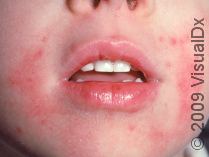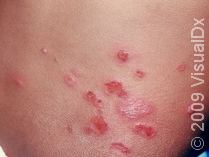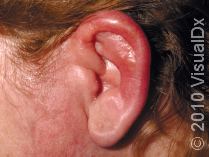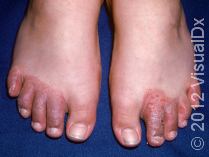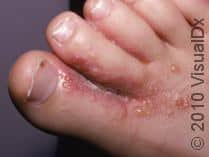Reducing Allergen Exposure for Improved Health and Wellbeing
Atopic dermatitis (AD), or eczema, is a skin problem that is characterized by itchy, red, and inflamed skin. Up to 20% of kids will have AD. One of the major driving factors of atopic dermatitis is barrier impairment. This basically means the skin is leaky and it is prone to irritation.
Skin is designed to keep things out. Why is this important? Well, there are a lot of bacteria out there. The skin keeps them out to prevent skin infections. Examples of skin infections include cellulitis, or impetigo in children.
The other thing the skin does is prevent chemicals from entering the deeper layers of the skin and body. When these chemicals come into contact with skin that is not intact, there is a greater risk for a skin allergy or skin irritation to develop. This is commonly known as allergic contact dermatitis or irritant contact dermatitis, respectively. Both of these conditions look exactly alike.
There are thousands of chemicals that can cause a skin allergy. But, we know that there are around 100 chemicals that are notorious for causing the majority of problems. The impaired skin barrier inherent in AD allows chemicals to penetrate deeper into the skin. For patients with AD, there’s a higher lifetime risk of developing a skin allergy to these chemicals.
The cosmetics and personal care products we use every day have fragrances, preservatives, and coloring agents. These are the chemicals that lead to allergic and irritant contact dermatitis. When you have a skin allergy to a common chemical, there is only a subset of products you can use every day to avoid developing an itchy, red rash. It doesn’t matter if you use medications such as topical steroids; a skin allergy gets better only with avoidance.
Conventional wisdom has been that only adults developed these kinds of skin allergies, after years of consistent exposure. However, more recent work has suggested that even young children under the age of 1 year can have skin allergies to outside chemicals. In fact, studies looking at children show that nearly half (48%) of high-risk children have a skin allergy.1 What does this mean? It means that children with impaired skin barriers from AD are developing skin allergies to chemicals. The scientific literature suggests that children with AD are 17 times more likely to have a skin allergy.2
What if we could prevent the development of allergic contact dermatitis in children? There are some experts who believe we can. They are advocating for a strategy called Pre-emptive Avoidance Strategy. If you or your child has AD, avoid developing allergic or irritant contact dermatitis by selecting cosmetics and personal care products without the most common triggers. The theory is that if your skin is never exposed to a potential allergen, allergic contact dermatitis cannot develop.
Unfortunately, navigating ingredient lists can be extremely challenging. There are so many chemicals with alternative names. Fragrances are often trade secrets, so specific ingredients are not identifiable on a product label. Also, this pre-emptive strategy has not been validated in a randomized controlled trial. In other words, we haven’t tested this strategy in a way that we can prove it works.
Given how common allergic contact dermatitis is, some families and patients are willing to make different purchasing decisions to reduce the risk. Here are some rules to live by. See our previous post on sensitive skin for a list of specific product recommendations.
- Look for fragrance-free products. Be aware that products with the label “un-scented” may actually use fragrances to mask smells. In addition, botanical ingredients are actually fragrances that can cause skin allergies, but manufacturers can still legally use the term “fragrance free.”
- Preservatives are also common causes of allergic contact dermatitis. Using thicker, ointment-based products is a good rule of thumb. These products have less water content and thus don’t need as much preservative. Petroleum jelly (Vaseline) is a good example of an affordable moisturizer without any preservatives of fragrances that may cause an allergic skin reaction.
- Using safe products without allergens may not mean a lifetime commitment. Most children with AD will eventually grow out of it and no longer exhibit clinical features of red, inflamed, and itchy skin. When a child has grown out of his or her eczema, a parent can consider switching back to regular cosmetic or personal care products.
References
- Goldenberg A, Mousdicas N, Silverberg N, et al. Pediatric contract dermatitis registry inaugural case data. Dermatitis. 2016;27(5):293-302. [PubMed]
- Allergic dermatitis in children [2017 annual meeting daily]. American Academy of Dermatology Meeting News website. http://aadmeetingnews.org/2017-annual-meeting-dailies/allergic-dermatitis-in-children/. Accessed March 17, 2017.
Last modified on July 6th, 2023 at 10:45 pm
